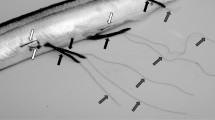Abstract
We monitored feeding behavior and survival of starved juvenile olive flounder experimentally infected with the gill monogenean Neoheterobothrium hirame. Infected flounder increased amount of the time spent in the water column by 117% when trying to capture live mysids, Neomysis sp. They also showed different feeding patterns from those of uninfected fish and made fewer attacks towards prey during one feeding attempt. Although the average numbers of mysids captured by individuals were similar between infected and uninfected fish, heavily infected fish tended to catch less prey. These results indicate that N. hirame reduces the feeding efficiency of the host for capturing live prey and possibly makes them more vulnerable to predation during feeding. We could not detect any obvious difference in survival rates between uninfected, lightly and heavily infected fish during 3 months of starvation. There was no evidence that starvation makes fish more susceptible to N. hirame. The present study provides first experimental evidence that N. hirame affects feeding behavior of juvenile olive flounder and supports the idea that this parasite indirectly reducing the host’s survival and may be responsible for the recent reduction of the flounder population in Japan.





Similar content being viewed by others
References
Anshary H, Yamamoto E, Miyanaga T, Ogawa K (2002) Infection dynamics of the monogenean Neoheterobothrium hirame among young wild Japanese flounder in the western Sea of Japan. Fish Pathol 37:131–140
Ogawa K (2002) Impacts of diclidophorid monogenean infections on fisheries in Japan. Int J Parasitol 32:373–380
Michine A (1999) Neoheterobothrium sp. found on Japanese flounder cultured commercially or maintained as spawners. Res Shimane Prefect Center Cult Fish 2:15–23
Ogawa K (1999) Neoheterobothrium hirame sp. nov. (Monogenea: Diclidophoridae) from the buccal cavity wall of Japanese flounder Paralichthys olivaceus. Fish Pathol 34:195–201
Mushiake K (2001) Epizootiology of Neoheterobothrium infection in wild Japanese flounder. Fish Pathol 36:252–253
Anshary H, Ogawa K, Higuchi M, Fujii T (2001) A study of long-term changes in summer infection levels of Japanese flounder Paralichthys olivaceus with the monogenean Neoheterobothrium hirame in the central Sea of Japan, with an application of a new technique for collecting small parasites from the gill filaments. Fish Pathol 36:27–32
Shirakashi S, Teruya K, Ogawa K (2008) Altered behaviour and reduced survival of juvenile olive flounder infected by an invasive monogenean parasite Neoheterobothrium hirame. Int J Parasitol 38:1513–1522
Tsutsumi N (2004) The origin and spreads of the monogenean parasite Neoheterobothrium hirame infecting wild olive flounder. PhD Thesis, The University of Tokyo, Tokyo
Shirakashi S, Yamada T, Yamada T, Ogawa K (2006) Infection dynamics of Neoheterobothrium hirame (Monogenea) on juvenile olive flounder, Paralichthys olivaceus (Temminck and Schlegel), in coastal waters of Japan. J Fish Dis 29:319–329
Mushiake K, Mori K, Arimoto M (2001) Epizootiology of anemia in wild Japanese flounder. Fish Pathol 36:125–132
Yoshinaga T, Kamaishi T, Segawa I, Yamano K, Ikeda H, Sorimachi M (2001) Anemia caused by challenges with the monogenean Neoheterobothrium hirame in the Japanese flounder. Fish Pathol 36:13–20
Yamashita Y (1997) Ecology and releasing techniques. In: Minami T, Tanaka M (eds) Biology and stock enhancement of Japanese flounder. Kouseisha-Kouseikaku, Tokyo, pp 107–116
Yoshinaga T, Kamaishi T, Segawa I, Kumagai A, Nakayasu C, Yamano K, Takeuchi T, Sorimachi M (2000) Hematology, histopathology and the monogenean Neoheterobothrium hirame infection in anemic flounder. Fish Pathol 35:131–136
Yoshinaga T, Kamaishi T, Ikeda H, Sorimachi M (2001) Experimental recovery from anemia in Japanese flounder challenged with the monogenean Neoheterobothrium hirame. Fish Pathol 36:179–182
Furuta S (1998) Basic studies on release techniques of hatchery-reared Japanese flounder. V—effects of starvation on feeding behavior and predation vulnerability of wild Japanese flounder juvenile. Nippon Suisan Gakkai Shi 64:658–664
Miyazaki T, Masuda R, Furuta S, Tsukamoto K (2000) Feeding behaviour of hatchery-reared juveniles of the Japanese flounder following a period of starvation. Aquaculture 190:129–138
Anshary H, Ogawa K (2001) Microhabitats and mode of attachment of Neoheterobothrium hirame, a monogenean parasite of Japanese flounder. Fish Pathol 36:21–26
Furuta S (1996) Predation on juvenile Japanese flounder Paralichthys olivaceus by diurnal piscivorous fish: field observations and laboratory experiments. In: Watanabe Y, Yamashita Y, Oozeki Y (eds) Survival strategies in early life stages of marine resources. A.A. Balkema, Rotterdam, pp 285–294
Barber I, Hoare D, Krause J (2000) Effects of parasites on fish behaviour: a review and evolutionary perspective. Rev Fish Biol Fish 10:131–165
Tanaka M, Seikai T, Yamamoto E, Furuta S (1998) Significance of larval and juvenile ecophysiology for stock enhancement of the Japanese flounder, Paralichthys olivaceus. Bull Mar Sci 62:551–571
Miyazaki T, Seikai T, Kinoshita I, Tsukamoto K (2004) Comparison of escape behavior of wild and hatchery-reared juvenile Japanese flounder Paralichthys olivaceus. Fish Sci 70:7–10
Shirakashi S, Yoshinaga T, Oka M, Ogawa K (2005) Larval attachment and development of the monogenean Neoheterobothrium hirame under low water temperature. Fish Pathol 40:33–35
Heming TA, Paleczny EJ (1987) Compositional changes in skin mucus and blood serum during starvation of trout. Aquaculture 66:265–273
Acknowledgements
The authors would like to thank staff members of Kamiura Station of National Research Institute of Aquaculture, especially K. Mori and T. Sugaya, for their generous supports, and also Shinpei Furuta of the Tottori Prefectural Fisheries Experimental Station for advice on experimental methodology. Thanks are also due to D. Grabner and D. Kallert for comments on an earlier version of the manuscript. This work is supported by a grant from the Japan Society for the Promotion of Science to S.S. (JSPS 15-11317).
Author information
Authors and Affiliations
Corresponding author
Rights and permissions
About this article
Cite this article
Shirakashi, S., Nishioka, T. & Ogawa, K. Neoheterobothrium hirame (Monogenea) alters the feeding behavior of juvenile olive flounder Paralichthys olivaceus . Fish Sci 75, 121–128 (2009). https://doi.org/10.1007/s12562-008-0011-y
Received:
Accepted:
Published:
Issue Date:
DOI: https://doi.org/10.1007/s12562-008-0011-y




